#while I only manage about 1-2kg of beans
Explore tagged Tumblr posts
Note
Do you grow beans? They’re very nutritious.
I do! And I agree, they're a very needed source of protein and iron. I love eating them too!
#growing enough beans to have a year-long stash takes a lot of growing space though#bean plants don't produce a lot of weight per plant#so you need like a field of beans in order to have dry beans available all year#tomatoes on the other hand#one plant can produce 5-10kg of tomatoes#so i can grow a year's worth of tomatoes in my little garden#while I only manage about 1-2kg of beans#which is like#a few meals#i still feel very special when i eat my own beans#but i can't wait to have my own growing space#so i can grow all year's stash#and mine are so colorful too!#i have black white spotted purple#brown green yellow#every year i pick my most beautiful beans and put them in one jar#and then admire that jar excessively on its beauty#its prominently displayed in my kitchen#on the fridge#so i can look at it in awe
10 notes
·
View notes
Text
Day 8, April 14, 2019: Hoi An Eco Tour and Da Lat
Unfortunately due to some flight changes on the part of Vietnam air, our original plan of a late flight to Da Lat was moved up to the afternoon. While this decreases our time in Hoi An, it did not prevent us from completing the Hoi An area Eco Tour, a piece of the Vietnam trip my grandmother really enjoyed when she visited last year.
Our tour guide from Jack Tran Tours was Viet and he greeted us with a smile and sense of humor bright and early at 7am. He took us on a short van ride to our beach cruiser bikes for the day. We hopped on and peddled out of the main city past rice paddies and new highways. Our first stop on the tour was a home belonging to three women in their early 60s: 61, 62. 63. One was widowed young when her husband died of a moto incident at 24. Another had a son. This is likely the one who also has a grandson who just turned one. Birthday decorations remain outside from the previous evening.The last woman never married. The three live together in a very basic home. They sleep on what westerners would call a rather antiquated bed, without a proper mattress. In addition to getting paid for hosting tourists like us, these woman make money by farming and selling their crops at the local market.They wake up at 2am to begin to water their crops, which they do by hand except for when it’s really really hot. These women have about 700 square meters and they grow mustard seeds (which take a week) as well as onions. Morning glory, lemon basil and more. Many of these plants require growing and then transplanting over to a new part of the farm for replanting. They fertile the soil with seaweed from a nearby fish farm, as well as cow or water buffalo dung. Two of the women are home when we visit. The oldest is 63 but looks far older. She is permanently hunched over—a direct result of her watering the garden which she can no longer do. That doesn’t stop her, she is still hustling about. A younger one is working and watering and urges us to take a try at watering and then planting. She too is slight and looks older than she is. Some of her teeth are missing, but that doesn’t stop her from smiling. Before departing she hands us a bag of fresh herbs and lettuce for our upcoming lunch. Talk about organic growers. 220 families around these parts once grew food for a living. Today, about 130 continue to farm and 90 or so have moved to work in the tourism industry. Farming is not a particularly lucrative trade. Despite being expert exporters of rice, just growing rice is a hard salary to live off. A 49 hectare dawn may yield one crop after three months. These 3 months earn the family less that what they can live on. After all a farm this big might yield 400kg in seed but after shelling, only 280kg of rice. If we assume 1 dollar = 2kg, for three months work and a whole harvest, only $150 might be yielded from this harvest. Most people supplement this farming income with other crops tourism etc. the Mekong delta which we’ll visit later this week is the largest and main exporter of rice in Vietnam. Unlike here they can harvest not two, but three crops of rice per year.
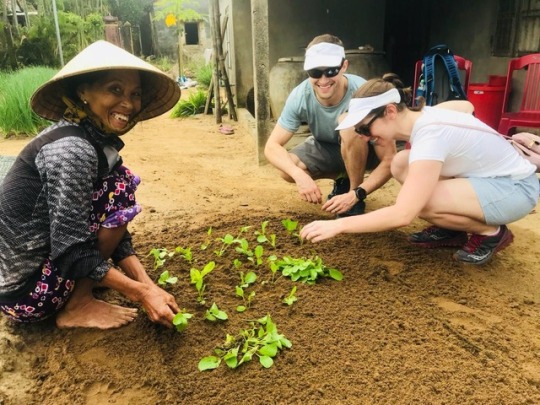
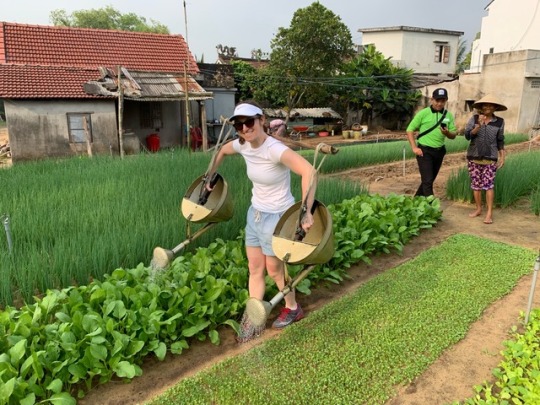
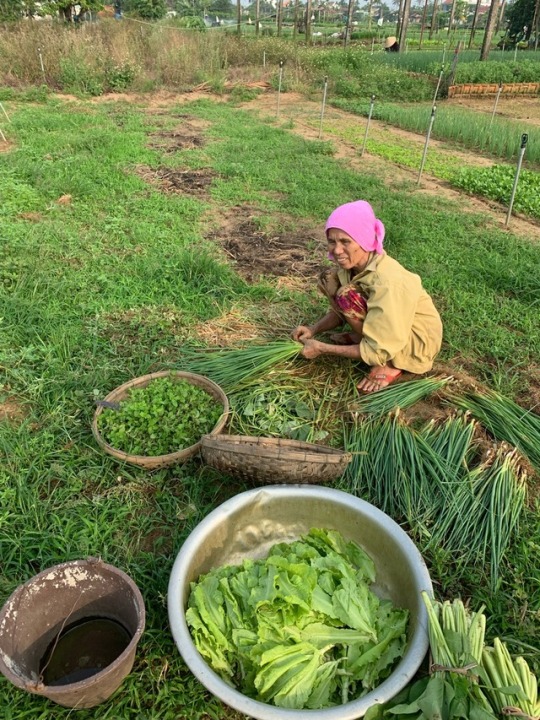
We get back on our bikes and cycle past a number of shrimp farms, and of course more rice paddies. Near to a large traffic circle and the highway we dismount once again for the most touristy part of the trip—water buffalo riding. This is when I learn that the only animal Kerran has ever ridden is a camel! The coolest part about this stop is actually the nearby brown cow (they don’t have black and white ones here) and the day old calf following it around as it learns to walk. After our carnival-like bull riding experience we get back on our bikes and cycle toward the river. We pass the countless beach side hotels and wave hello to the ocean. Like Danang, more resorts are popping up often. Our guide Viet’s wife works part time in one hotel doing laundry, but not for the next six months as she had their first child six days ago!
On the river side, we board a boat and take off our shoes as instructed. We are in Coco River, names for the long necked bird (is egret) that you can see everywhere. Coconut cake and sliced pineapple await us for a morning snack. We begin sailing away from land toward the open bay. Our first stop is a small fishing boat. A jolly woman rows from the back while a man throws a net out repeatedly. The net is beautiful as it’s tossed. We board their boat and see that they’ve just caught one small fish. Kerran tries and does well on his first try. I kind of suck at it. We don’t catch anything but the experience is cool. Admittedly this is pretty late in the AM for this.
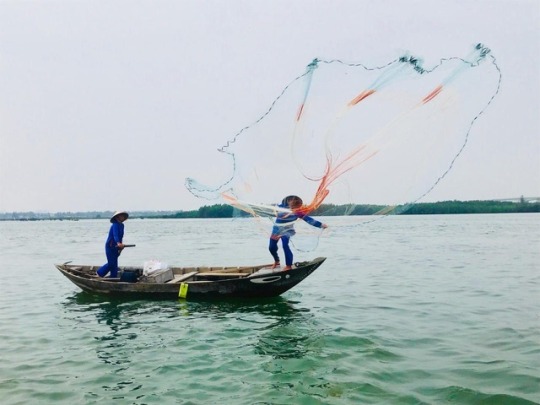
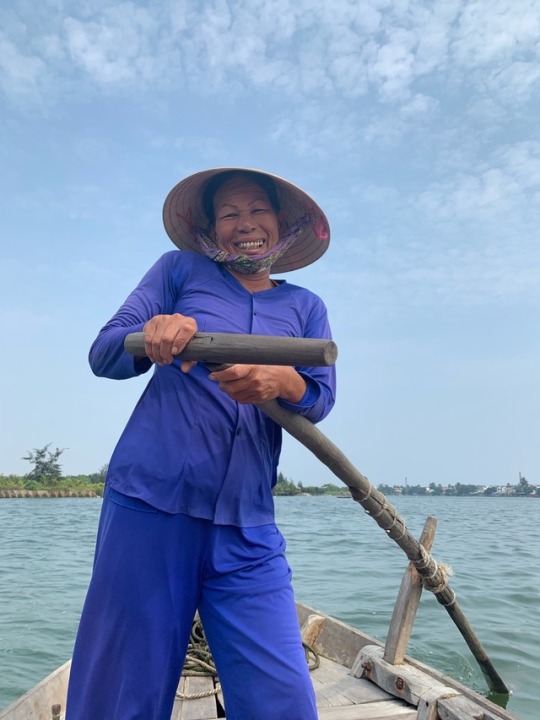
We get back on our bigger boat and sail on. We pass the fishing village of a Cua Dai (another name for the river) where Viet grew up. This is a village with about 5000 people. In 2000 about 90% of people worked in fishing. Today, only 40% work in fishing and the majority of others have moved to tourism. Viet is one of five kids—his brother is in construction but all three sisters work in hotels as chambermaids, doing laundry etc. All of the girls stopped school at age 12 while the boys continued. Today however schooling is compulsory for both genders until age 18. Similar to our first guide, Viet got electricity in 1993. He remembers the whole village circling around the two televisions in 1998 to watch a soccer match. In 1999 UNESCO names Hoi An a historic world heritage site. Tourism has been growing exponentially ever since. In 2017 Hoi An saw and estimated 2.5M tourists. Last year there were 3.8M. There are 150,000 people living in Hoi An! Viet thinks about 70% are from China and Korea, and this is less good as most reside in Chinese owned hotels in nearby Danang.
We sail onward toward the water coconut forests. These plants aren’t endemic to the area and are originally from the Mekong delta and used to help prevent erosion. The coconut forest was also a hiding place for about 140 Vietnamese during the American war. Only about 40 survived, half of which were heavily injured. In this place about 1000 people died, including the Vietnamese soldiers, Americans and locals. In wet season they hid right in the water eating fish and the oysters that dot the palm trunks. In dry season they covered themselves with mud to camouflage themselves from the Americans. Today it’s a beautiful area (well, the parts that aren’t littered with trash). The crew of our own boat demonstrated how to use circular basket boats made of bamboo. They are waterproofed with tar and cow dung. The Vietnamese originally created these (based on a Welsh boat) because the french taxes the length of boats and this significantly decreased the cost. Today they cost about 200-250 US dollars. The staff do a demonstration, cheekily singing Gangnam style as they go. Then we get in and it feels as if we’re on a tilt a whirl. After this bit of touristy and somewhat gimmicky fun, Viet also boards the boat and we sail through the forest. We pick up garbage as we go and eventually reach an area without too much litter. Both Viet and the boat rower start using palm leaves to create some very impressive origami. He also constructs two fishing rods and baits them with an oyster from the palm leaves. We are going fishing for crabs. Kerran lures the crab in with his bait and we scoop the black crabs with purple pinchers into what looks like a leftover gasoline or washing detergent canister. We catch a few but they are all quite small so we ultimately let them go.
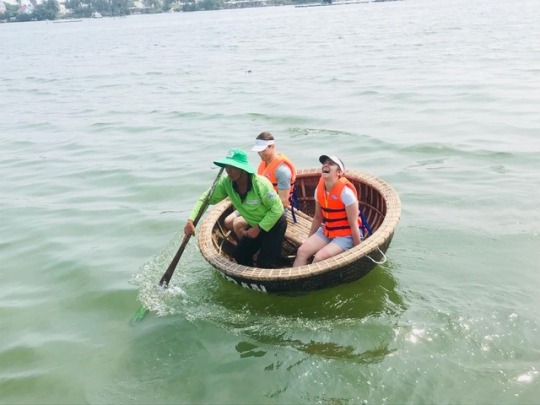
We then board the big boat again and head toward our last stop to try another type of fishing. Nearby the beach we board the small basket boat once again to get to shore. On shore is a large contraption used for reeling in a giant net. Typically these fisherman are out from 5pm to 3am but our host is up and about for us. He’s heavily tanned from being in the sun and has use only of one arm and yet he manages to reel in this heavy thing. The large net has holes in very strategic places and he strategically moves the net to get out the fish. This morning we catch nothing but small babies so we let those go.
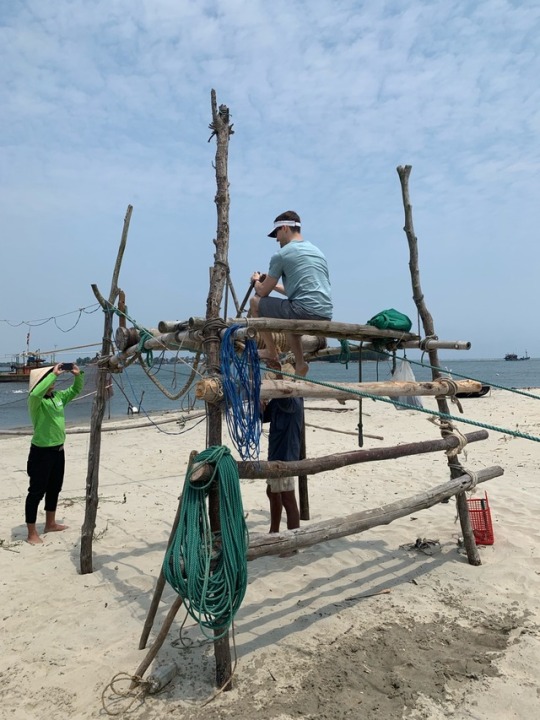
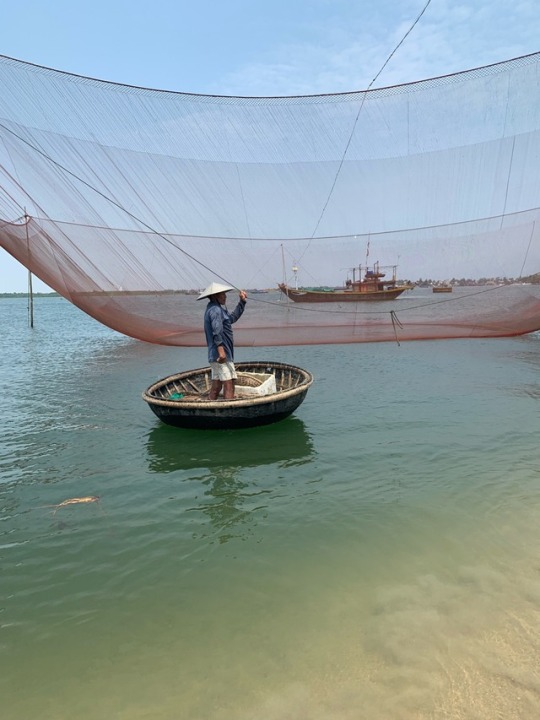
Back on board the bigger boat the crew is making us lunch. As always with these touristy things, there is more food than we can handle. We start with spring rolls, then get a calimari salad, grilled mackerel, tons of rice, traditional morning glory and the pancake spring rolls I had last night. Dessert is mung bean cookies. I am completely stuffed. We sail back to shore and Viet boards a small van with us back to our hotel. The driver could be a NYC cab driver—he’s a bit aggressive and swerved around tour busses. I am genuinely fearful for the motorbikes on the road!
We’re back to the hotel in time to freshen up before Hoai picks us up at 1:25pm to take us to the airport. We bid farewell to Hoai and take the one hour flight to the mountain region of Da Lat.
Boy are we glad when we get here. It’s cool!!! Our guide, who insists we call him Frankie, meets us at the airport. He’s clearly more outdoorsy than the other guides, and much younger, just a few years older than we are. He studied law and English at university but after a year of attempting to practice law in Saigon after university, he was itching to come back and become a guide. He says his mom was not thrilled! He has both a ten year old and 1 year old girl.
We check in at the Dalat Palace Hotel, originally built by the french and finished in 1922. It has all the charms of a historic hotel but admittedly, is in need of a bit of a renovation.
We freshen up and meander into town where a bustling night market takes place. This weekend is also a holiday weekend so Vietnamese tourists are everywhere. The night market here is less touristy and more authentic-people selling warm weather clothes and countless foods. You can easily identify the Vietnamese tourists because they are dressed in hats and scarves. It’s probably about 65 degrees.
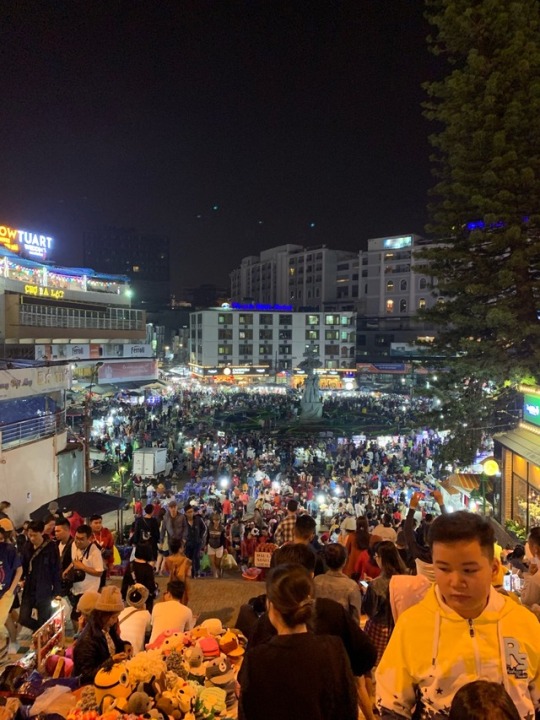
We eat a bit off the main drag at a small restaurant called Trong Dong. When we arrive we’re the only ones there but a few other couples wander in. There are only about 7 or 8 tables here—each covered with a plaid table cloth that is then layered with a white one. It’s quiet and cute with an extensive menu of Vietnamese food. We learn at this dinner that Da Lat produces wine (it’s okay). I get a delicious clay pot of spicy pork.
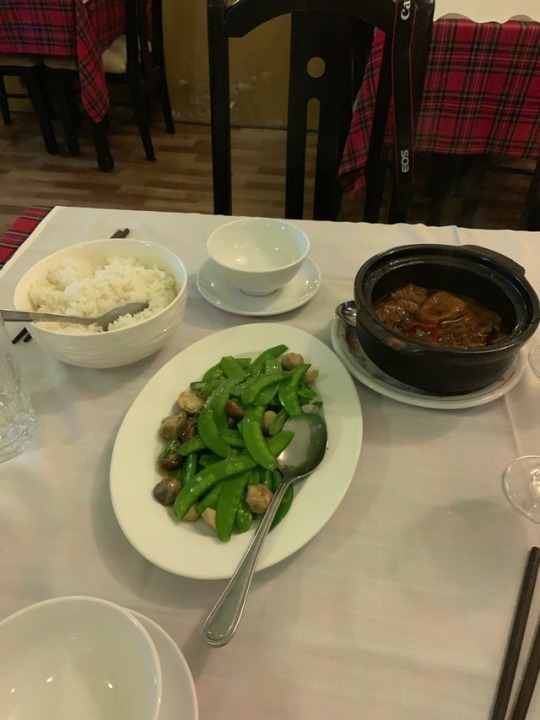
We’re exhausted after dinner and meander our way back through the night market toward tour hotel which is perched on a hill and overlooks the towns lake. We stop to take pictures of an impromptu dance session and the boards of people eating and enjoying the market. This city is funky—it’s both beautifully adorned with flowers (earning it its name of the flower city) and also somewhat kitschy with lights all around. We’re ready to explore!
0 notes